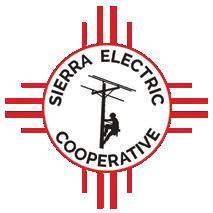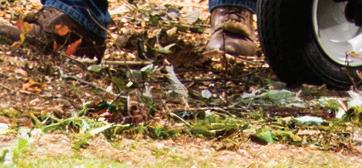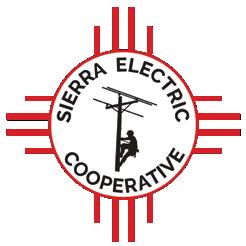enchantment
SIERRA ELECTRIC
COOPERATIVE


SIERRA ELECTRIC
COOPERATIVE

Every May, Electrical Safety Month serves as a vital reminder of the importance of preventing electrical hazards in the kitchen and around the house Page 14

May 1, 2025 • Vol. 77, No. 5
USPS 175-880 • ISSN 0046-1946
enchantment (ISSN 0046-1946) is published 10 times a year—every month except June and December—by the New Mexico Rural Electric Cooperative Association, 614 Don Gaspar Ave., Santa Fe, NM 87505. enchantment provides reliable, helpful information on rural living and energy use to electric cooperative members and customers.
More than 113,000 families and businesses receive enchantment magazine as electric cooperative members. Nonmember subscriptions are available at $12 a year or $18 for two years, payable to NMRECA. Allow four to eight weeks for first delivery.
PERIODICAL POSTAGE paid at Santa Fe, NM 875019998 and additional mailing offices.
CHANGE OF ADDRESS: Postmaster, please send address changes to 614 Don Gaspar Ave., Santa Fe, NM 87505-4428. Readers who receive the publication through their electric cooperative membership should report address changes to their local electric cooperative office.
THE NEW MEXICO RURAL ELECTRIC COOPERATIVE ASSOCIATION provides legislative and educational services to the cooperatives that are members of the association and deliver electric power to New Mexico’s rural areas and small communities. The mission of the New Mexico Rural Electric Cooperative Association is to strengthen, support, unify and represent cooperative member interests at the local, state and national levels. Each cooperative has a representative on the association’s board of directors, which controls the editorial content and advertising policy of enchantment through its Publications Committee.
OFFICERS OF THE BOARD OF DIRECTORS
Tim Morrow, President, Springer Electric Co-op, Springer; Charles G. Wagner, Vice President, Western Farmers Electric Co-op, Anadarko, Oklahoma; Duane Frost, Secretary-Treasurer, Central NM Electric Co-op, Mountainair.
BOARD OF DIRECTORS
Rusty Gwynne, Central Valley Electric Co-op, Artesia; Chris Martinez, Columbus Electric Co-op, Deming; Keith Gottlieb, Continental Divide Electric Co-op, Grants; Antonio Sanchez, Farmers’ Electric Co-op, Clovis; Manny Bustos, Jemez Mountains Electric, Española; Bobby Ferris, Lea County Electric Co-op, Lovington; James Ortiz, Mora-San Miguel Electric Cooperative, Mora; Thomas G. Rivas, Northern Río Arriba Electric Co-op, Chama; Preston Stone, Otero County Electric Co-op, Cloudcroft; Eric Segovia, Roosevelt County Electric Co-op, Portales; Raymond Ruffini, Sierra Electric Co-op, Elephant Butte; Manny Gonzales, Socorro Electric Cooperative; Joe Reeser, Southwestern Electric Co-op, Clayton; Wayne Connell, Tri-State G&T Association, Westminster, Colorado.
NEW MEXICO RURAL ELECTRIC COOPERATIVE ASSOCIATION
614 Don Gaspar Ave. Phone: 505-982-4671 Santa Fe, NM 87505 Fax: 505-982-0153 nmelectric.coop enchantment.coop Vince Martinez, CEO Tom Condit, Communications Manager
DISPLAY ADVERTISING: Rates available upon request. Co-op members and New Mexico display advertisers, email Shaylyn at enchantmentads@ nmelectric.coop or call 505-252-2540. National representative: American MainStreet Publications, 800-626-1181.
Advertisements in enchantment are paid solicitations and are not endorsed by the publisher or the electric cooperatives that are members of the New Mexico Rural Electric Cooperative Association. PRODUCT SATISFACTION AND DELIVERY RESPONSIBILITY LIE SOLELY WITH THE ADVERTISER.
© 2025 New Mexico Rural Electric Cooperative Association, in partnership with Pioneer Utility Resources. Reproduction prohibited without written permission of the publisher.






enchantment photomonthlywinner
Take a photo of you holding YOUR MAGAZINE AND WIN!
Congratulations to Anthony Peralta, an Otero County Electric Cooperative lineworker. He read his enchantment before skydiving over Eloy, Arizona, in salute to veterans.
Anthony wins $20!

Take a photo of yourself or someone else with the magazine and email it with a few words about the photo. Include your name, mailing address and co-op name.
One lucky member will win $20. Submitting your photo(s) gives us permission to publish or post the photo(s) in enchantment, on Facebook and in other media outlets.
Email tcondit@nmelectric.coop.


General Manager
General Manager
Guy Payne
Denise Barrera
Address
Address
610 Highway 195 • P.O. Box 290
610 Highway 195 • P.O. Box 290
Elephant Butte, NM 87935
Elephant Butte, NM 87935
Telephone
Telephone
575-744-5231
575-744-5231
Outages
Outages
888-336-3380
888-336-3380
Fax
Fax
575-744-5819
575-744-5819
Email sierra@secpower.com
Email sierra@secpower.com
Website www.sierraelectric.org
Website www.sierraelectric.org
Office Hours
Office Hours
8 a.m. to 5 p.m. (M-F)
8 a.m. to 5 p.m. (M-F)
Board of Trustees
Board of Trustees
President
Tami Garrett, Las Palomas, District 3
President Tami Garrett, Las Palomas, District 3
Vice President
Vice President
Raymond Ruffini, Elephant Butte, District 2
Raymond Ruffini, Elephant Butte, District 2
Secretary
Warren Strong, Elephant Butte, District 2
Secretary Warren Strong, Elephant Butte, District 2
Treasurer
Treasurer
Darryl Sullivan, Monticello, District 3
Darryl Sullivan, Monticello, District 3
Dennis Franklin, Hillsboro, District 1
Dennis Franklin, Hillsboro, District 1
Judy Smith, Caballo, District 1
Judy Smith, Caballo, District 1
Paul Scott, Elephant Butte, District 2
Paul Scott, Elephant Butte, District 2
Ray Hodges, Elephant Butte, District 2
Ray Hodges, Elephant Butte, District 2
April Romero
April Romero
Chuchillo, District 3
Chuchillo, District 3
Board Meeting
Board Meeting
People are always losing their phone chargers.
To replace them, many people buy low-cost, generic plug-in chargers and charging cables. While they can save money, the decision can be dangerous, creating burn and fire hazards.
The Sierra Electric Cooperative board of trustees retired patronage capital to the members of Sierra Electric for the years 2006 (100%) and 2007 (50%), totaling $198,992.72. Checks were mailed out April 1. If you were a member in those years, you will receive a check within the next few weeks.
“Although it is tempting to pick up an inexpensive phone charger to save money, buying and using cheap chargers is one place you might not want to cut corners,” says Erin Hollinshead, executive director of the Energy Education Council/Safe Electricity program. “Using an authentic replacement charger made by your mobile phone’s manufacturer is always a better choice.”
In 2024, Sierra Electric Cooperative bought 543,132 kilowatt-hours of renewable energy.
Along with creating a potential burn and fire hazard, using cheaply made charging components and devices can also cause shock and electrocution. Beyond these potential dangers, the cheaper chargers may cost you more in the long run since they can cause damage to your electronic devices.
When using charging gear, Safe Electricity recommends the following:
• Do not leave charging devices unattended.
The New Mexico Public Regulation Commission requires that cooperatives report annually on renewable energy purchased. For this report, renewable energy means electrical energy generated by a low- or zero-emissions generation technology with substantial long-term production potential. This includes resources such as solar, wind and hydropower resources.
• Always keep charging items away from flammable objects—especially bedding—and do not take them to bed with you. Tell kids and teens to never place any charging device under their pillow. The heat generated gets trapped, which could cause the pillow or bed to catch fire.
• Do not touch charging electronic devices with wet hands or while standing in water.
• Make sure charging components are certified by a reputable third-party testing laboratory.
The board of trustees meets the third Friday of the month at 8:30 a.m. in the cooperative boardroom. This institution is an equal opportunity provider and employer.
The board of trustees meets the third Friday of the month at 8:30 a.m. in the cooperative boardroom.
This institution is an equal opportunity provider and employer.
Tri-State G&T offers rebates to members of Sierra Electric Cooperative through its Beneficial Electrification and Efficiency program. This program benefits members by using electricity in technology that has historically been powered by fossil fuels.
• Only buy product-approved chargers and cables (those made or certified by the manufacturer). Using cheaper devices can cause damage to the USB charge chip, which can have a lasting impact on how quickly and effectively your device charges.
Electrification can save you money, improve your quality of life, benefit the environment by reducing overall emissions, and foster a more robust and resilient grid. For more information on available rebates, contact our office at 575-744-5231 or email us at sierra@secpower.com
• Look out for fakes or imposters claiming to be brand approved. If the price seems too good to be true, it probably is. n
Have you ever noticed your lights blinking during a thunderstorm? Or perhaps you have arrived home to discover the clock blinking on your microwave.
When this happens, you likely experienced a brief disruption to your electric service, which could be the result of a power surge or a power blink.
Power surges are brief voltage spikes or disturbances of a power waveform that can damage, degrade, or destroy electronic equipment within your home or business. Most electronics are designed to handle small variations in voltage; however, power surges can reach amplitudes of tens of thousands of volts — this can be extremely damaging to your electronic equipment. Surges can be caused by internal sources, like HVAC systems with variable frequency drives, or external sources like lightning or damage to lines or transformers. Sierra Electric encourages all members to install surge protective devices (such as surge protector power strips) to safeguard your sensitive electronics.
If you’re experiencing frequent surges in your home or business and you believe the cause is internal, contact a qualified electrician to inspect your electrical system.
Power blinks are typically caused by a fault (short circuit) on a power line or a protective device reacting to try and “clear” a fault.
Faults occur for a variety of reasons, including when squirrels, birds, bats, snakes or other small animals contact an energized power line. Other causes include tree branches, weather, vandalism and other things beyond our control such as acts of third parties, animals and acts of God.
Power blinks also occur when protective devices acting like circuit breakers work to detect the fault. These brief interruptions are actually good. They signal the equipment is working as it should to prevent a prolonged outage. If a circuit is unable to clear the fault by the third attempt, an outage occurs.
Any time you experience repeated disruptions to your electric service, please let us know by calling us at 575-744-5231.
What can you do to help prevent power blinks?
Do not hang anything on SEC poles. That includes flags, security cameras, animal feeders, bird houses, or anything that attracts animals. Keeping the poles clear is also a good way to help keep line workers safe. n


BACKGROUND: Lightning is another cause of power interruptions and is a good reason to install devices

By Vince Martinez, NMRECA CEO
As always, success at this year’s legislative session can be measured in many ways.
Overall, the team at the Statewide Association tracked and monitored more than 116 bills. Of the 11 bills we opposed, none passed. We supported 14 bills, of which 8 passed, including HB-323, which reversed overburdensome requirements for co-ops regarding engineer stamps.
Another bill we supported was SB-31, which will provide 0% interest loans to cooperatives and local governments in response to natural disasters and wildfires.
Our success at this year’s session and in previous years is rooted in strong support from our state representatives and senators who represent rural cooperatives.
Along with other moderate legislators who understand the vital role rural electric cooperatives play in the continued economic stability of rural New Mexico, we were able to advocate for and protect the interests of our member-owners.
We thank all legislators who sacrifice their time away from their jobs, businesses, and families to serve in the only non-paying legislature in the country.

Electric cooperatives can focus on their annual meetings now that the legislative session is over and all the bills have been signed or vetoed.
All 15 of New Mexico’s member distribution cooperatives and two generation and transmission cooperatives have begun hosting annual meetings.
Annual meetings are a good time to gather with friends, neighbors and fellow member-owners and hear updates about your cooperative from the elected board members and CEOs.
Your annual meeting is an illustration of what separates electric cooperatives from investor-owned utilities and is rooted in the seven cooperative principles:
1. Democratic member control
2. Open and voluntary membership
3. Members economic participation
4. Autonomy and independence
5. Education, training, and information
6. Cooperation amongst Cooperatives
7. Concern for community
I encourage you to attend and participate in your annual meeting. Of course, you’ll also have a chance to win great door prizes and have a hardy meal.










































By Miranda Boutelle
Q: What does “beat the peak” mean, and why should I care about it?
A: When utilities talk about “beat the peak,” it’s a call to action for energy consumers to reduce electricity use during periods of highest demand. Using less energy during peak times can ease the strain on the electric grid, benefit your electric utility and sometimes lower your electric bill.
Electricity generation and energy supply must match consumption in real time to ensure safe, reliable power. Every moment of every day, an entire workforce monitors energy use, adjusting power plant production up or down as needed to keep the grid balanced.
As energy demand grows, we can all do our part to use less. To put this in perspective, peak electricity demand is expected to increase by 38 gigawatts over the next five years, according to the Energy Information Administration. That’s like adding another California to our nation’s power grid.
Peak time varies for each utility but is typically in the morning when people get ready for the day and in the evening when they return home. During these times, we turn on lights, cook, adjust the thermostat, run the dishwasher and do laundry—to name just a few energy-consuming activities.
Typically, the price of power increases when demand is higher. Reducing your electric use during peak times can help lower market prices for everyone and lessen stress on the electric grid.
Electric utilities set electricity rates to cover costs. Some utilities have time-of-use rates that reflect higher costs during peak demand periods.
Whether they have time-of-use rates or not, these tips can help keep costs down for your utility and establish off-peak energy habits:
As a general rule, try to spread out your use of equipment and appliances. For example, I avoid cooking while also washing dishes and clothes. Running a lot of hot water causes your water heater to use more energy, too.
Increasing the energy efficiency of your home can lower its impact on the grid. Weatherize windows and doors, and add insulation to improve the comfort of your home. You can also

consider upgrading to energy-efficient appliances or using energysaving features on your existing appliances.
If you haven’t already, switch your incandescent lighting to LEDs, which use at least 75% less electricity and last up to 25 times longer, according to the U.S. Department of Energy. There are many affordable options on the market.
Schedule your dishwasher run time. My dishwasher, which is several years old, has a “delay start” button. This is also handy if your dishwasher is loud. Setting it to start after you go to bed shifts that energy consumption to off-peak hours, and you don’t have to hear it.
Running your washing machine and dryer during nonpeak hours can help, too. If you’re in the market for a new washer or dryer, look for a model with a high Integrated Modified Energy Factor and a low Integrated Water Factor to save water and energy.
Also, consider switching your charging habits for all devices to off-peak hours. If you have an electric vehicle, use the scheduled charge settings. Plug in your vehicle when you get home, and it starts charging automatically during the off-peak hours you choose.
Small changes at home can make a big difference to the energy grid. Incorporate these energy-wise habits into your daily routine.





Mars and Jupiter remain visible in our evening skies during May. Jupiter is already fairly low in the west as darkness falls. Early in the month, it sets just more than an hour after the end of dusk. By month’s end, it sets before twilight is over, and we won’t be seeing it again until it emerges into our morning sky during the latter part of July.
Mars, meanwhile, is fading now that it is pulling away from its closest approach to Earth back in January, but it remains easily visible until setting an hour or so after midnight.
The brilliant Venus and the dimmer Saturn form a close pair as they rise around the beginning of dawn in early May. As the month progresses, the two worlds gradually pull apart and Saturn climbs higher into the east, but they remain a dramatic sight together. Adding to the spectacle, the crescent moon passes through the region on the mornings of May 22-23.
The Eta Aquarid meteor shower, one of the stronger showers in May, peaks in the early-morning hours of May 5-6. With the moon just past its first quarter phase, skies should be relatively
dark. Viewers may see up to 20 meteors per hour. In the Southern Hemisphere, where the radiant is higher in the sky, the rate could reach 40 to 50 meteors per hour.
The Eta Aquarids are debris from Halley’s Comet, which last appeared in 1986 and just passed through aphelion—its farthest point from the sun—a little more than a year ago. It comes our way again in 2061.
You may notice there aren’t as many bright stars in our May evening skies as there are at other times of the year. During May, we are looking out away from our galaxy into intergalactic space. While there are fewer stars in this direction with the naked eye, telescopes allow you to see a large numbers of other galaxies.
The nearest large cluster of galaxies is in the constellation of Virgo—just south of overhead during the mid-evening hours— and is some 55 million light-years away from us. The Virgo galaxy cluster contains more than a thousand galaxies, a few hundred of which are detectable with small to moderate-size backyard telescopes. e







































By Scott Flood
When lineworkers are perched in a bucket truck, repairing power lines along a busy road, they have good reason to be concerned about their safety. Although most lineworkers are less apprehensive about working with high voltages or falling, their biggest worry is also the most unpredictable—a distracted driver hitting their vehicle or a nearby power pole.
The National Safety Council reported that 891 people were killed and 37,701 people were injured in work zone crashes in 2022, the most recent year for which statistics are available. Most of those crashes occur in construction sites, which are usually well marked.
Electric utility crews are likely to face even greater danger, as they often work alone along remote stretches of roads, frequently in heavy rain or other adverse weather conditions that can make it harder for passing drivers to see them.
The danger of work zone crashes led every state to adopt move-over laws that require drivers to lower their speeds and switch lanes when possible to protect emergency vehicles. The goal is to provide an added safety buffer and minimize the potential for accidents. Drivers caught violating the laws can face penalties, such as significant fines.
Unfortunately, the Journal of Road Safety reports that just 14 states’ move-over laws protect other types of service
vehicles, such as construction trucks and utility vehicles. That means drivers in those states are under no legal obligation to give lineworkers that added margin of safety.
Compounding the issue is the dramatic increase in distracted driving. The National Highway Traffic Safety Administration has reported that as many as 1,000 Americans are injured each day because of activities that take drivers’ attention away from the road. The most common is reading and responding to text messages. If a driver traveling at 55 mph glances at their phone for just five seconds, they’ll have traveled the length of a football field before returning their gaze to the road.
The design of today’s vehicles contributes to distractions. Many vehicles have complex controls for entertainment and climate that demand the driver take their eyes off the road to make even simple adjustments.
Geography can also be a factor. Electric utilities serving rural and remote areas often have power lines along twisty and hilly roads. Locals accustomed to driving those roads at high speeds may be startled and have little time to react when they encounter a work crew past a hill or around a curve.
Besides the potential for lineworker injuries, accidents can also damage or destroy expensive service vehicles, reducing a utility’s ability to respond to outages and other

problems. Power poles and other infrastructure may also suffer severe damage.
Additionally, many of the tasks performed by lineworkers, such as reconnecting high-voltage power lines, are inherently dangerous and require their complete focus. When their attention is distracted by speeding or noisy vehicles, they’re more likely to make mistakes that can complicate the repair or cause injury.
Electric utility employees aren’t only at risk when their vehicles are parked and repairs are underway. Lineworkers frequently have to drive slowly along the road’s shoulder to pinpoint broken power lines or failed transformers, especially in darkness or conditions that interfere with visibility.
Many state transportation agencies have work zone awareness programs. Amplifying those efforts by devoting part of a utility’s advertising, publicity and social media to roadside safety reminds drivers of the importance of giving lineworkers a wide berth.
Utilities are considering ways they can modify bucket trucks and other service vehicles to make them more visible.
Warning signs and cones are often placed in advance of the work zone during emergency outages where flagging crews are unavailable.
Sometimes, a little bit of extra attention is all that’s needed to prevent a serious incident. e

Operation of vehicles on approach of moving authorized emergency vehicles; operation of vehicles on approach of certain stationary vehicles.
A. Upon the immediate approach of an authorized emergency vehicle displaying flashing emergency lights or when the driver is giving audible signal by siren, the driver of every other vehicle shall yield the right of way and shall immediately drive to a position parallel to, and as close as possible to, the right-hand edge or curb of the roadway clear of any intersection and shall stop and remain in that position until the authorized emergency vehicle has passed, except when otherwise directed by a police officer.
B. Upon approaching a stationary authorized emergency vehicle or a recovery or repair vehicle displaying flashing emergency or hazard lights, unless otherwise directed, the driver of a vehicle shall:
(1) if reasonably safe to do so, drive in a lane not adjacent to the stationary vehicle, decrease the speed of the vehicle to a speed that is reasonable and prudent under the circumstances and proceed with caution; or (2) if it is not reasonably safe to drive in a lane not adjacent to the stationary vehicle, decrease the speed of the vehicle to a speed that is reasonable and prudent under the circumstances, proceed with caution and be prepared to stop.
C. This section shall not operate to relieve the driver of an authorized emergency vehicle or the driver of any other vehicle from the duty to drive and park with due regard for the safety of all persons using the highway.

By Abby Berry and Nina Todea
Every May, Electrical Safety Month serves as a vital reminder of the importance of preventing electrical hazards at home. Electricity powers nearly every aspect of modern life, but if handled improperly, it can pose serious risks, including injuries and property damage.
Your electric utility understands the risks associated with improper electricity use, which is why we’re committed to reminding you to stay vigilant and practice electrical safety year-round.
By following key safety practices, you can reduce the risk of electrical hazards and ensure your family stays protected. Here are eight essential tips for powering up safely at home:
1. Be vigilant. Regularly inspect your home’s electrical system, including smoke alarms and carbon monoxide detectors, for signs of damage or outdated components.
Electrical fires can start silently and out of sight, making functional smoke alarms and carbon monoxide detectors essential for early detection. Test alarms monthly, replace batteries annually and ensure you have alarms installed in key areas of your home, including inside and outside of bedrooms.
2. Replace frayed electrical wires or cords. The Electrical Safety Foundation International estimates roughly 3,300 home fires originate from extension cords every year, primarily due to overloading, overheating or fraying. If you’re relying on extension cords as permanent power solutions, consider contacting a qualified electrician to install additional outlets where you need them.
3. Use surge protectors. Safeguard your sensitive electronics and appliances with surge protectors. These handy devices help divert excess voltage away from your electronics, reducing the risk of damage or electrical fires. Not all power strips include surge protection, so read the product label carefully. Additionally, surge protectors can lose effectiveness over time and should be replaced when damaged or outdated.
4. Practice safe use of power strips. Avoid overloading electrical outlets with power strips that exceed the outlet’s capacity. High-energy devices, such as heaters, microwaves and hair dryers, should be distributed across multiple outlets. Overloading an outlet with “busy” power strips can lead to overheating and create a fire hazard, so be sure to check the power strip’s wattage rating before plugging in items.
5. Don’t mix water and electricity. It may seem obvious, but accidents involving water contact with electrical items happen. Always keep electrical appliances and devices away from water sources, such as sinks, bathtubs or swimming pools. Make sure your hands are dry before touching any electrical switches or appliances. Never handle electrical devices with wet hands. Ground Fault Circuit Interrupters should be installed in areas where water and electricity are typically in proximity, including kitchens, bathrooms and outdoor outlets.
6. Hire a qualified electrician for major work. While DIY projects may seem like a tempting way to save money, working with electricity requires specialized knowledge of your home’s electrical system and national safety codes. Cutting corners can be a costly mistake beyond your wallet.
Recent data from the U.S. Consumer Product Safety Commission reports nearly 400 electrocutions in the United States each year, 14% of which are related to wiring hazards. A licensed electrician has the expertise to handle major electrical tasks, such as installing new wiring, upgrading your circuit breaker panel or troubleshooting electrical issues. When it comes to electricity, safety should always be your priority—leave the major jobs to the experts.
7. Educate family members. One of the best ways to ensure the safety of everyone in your household is to talk about electrical safety. Teach children not to play with electrical outlets or appliances, and ensure they understand the potential dangers of electricity. Create and practice a home fire escape plan that includes electrical safety precautions in the event of an emergency.
Practicing electrical safety at home is essential for protecting your family, property and peace of mind. Remember, electrical safety isn’t just a one-time effort—it’s a year-round responsibility. Taking these steps can help ensure a safer, more secure home for you and your loved ones. e
Homeowners should always take precautions to mitigate the risk of electrical fires and other electrical hazards—but what happens if those precautions are still subject to human error?
Faulty wiring, power surges or malfunctioning appliances can ignite flames in an instant. In those critical moments, knowing exactly what to do can mean the difference between safely containing an electrical fire and facing a devastating loss. Follow these guidelines if an electrical fire breaks out in your home:
Do cut the power: If a faulty appliance causes the fire, unplug it immediately. If you can’t reach the plug but have a safe path to your home’s breaker panel, turn off the electricity at the panel.
Do use a fire extinguisher: Not all fire extinguishers are created equal. Electrical fires should be extinguished with Class C fire extinguishers, which are specifically designed to address electrical fires. Fire extinguishers should only be used on small, contained fires. Electrical Safety Foundation International recommends homeowners buy a fire extinguisher large enough to effectively put out a small fire, but not so heavy that it is difficult to handle. In a pinch, small electrical fires can also be smothered with a fire blanket or baking soda.
Don’t use water: Although it may be your first instinct, water conducts electricity and can make the fire worse or cause electrocution.
Do evacuate immediately: If the fire spreads out of your control, get everyone out of the house and to safety, then call 911. Closing doors behind you can slow the spread of the fire.


Your inbox shouldn’t feel like a junk drawer
By Sable Riley
Spring cleaning isn’t just for your home— your digital spaces need attention, too.
Much like cluttered closets or messy garages, disorganized digital environments can be overwhelming. Searching through digital clutter for an important email or document can be incredibly frustrating. But tidying and streamlining your digital environment can improve productivity and give you more peace of mind. With more of our lives happening online, a little spring cleaning goes a long way.
Begin with your inboxes. Emails pile up quickly. A study by Campaign Monitor shows the average person receives more than 120 emails daily, many of which go unopened. Cut down on clutter by unsubscribing from newsletters you never read and organizing important emails into labeled folders like “Bills,” “Work” and “Family.”
“Your mind is for having ideas, not holding them,” says productivity expert David Allen, author of “Getting Things Done.” “Digital clutter is just as distracting as physical clutter.”
Next, focus on decluttering files on devices and cloud storage.

Deleting outdated documents, apps
you never use, and old photos and files frees space and helps you access important information quickly. An organized digital space is easier to manage and reduces frustration.
Boosting cybersecurity is equally important. Just as homeowners lock their doors and windows, enabling automatic updates on devices guards against cyberthreats.
“Regularly updating software is one of the simplest, yet most powerful, steps you can take to prevent cyberattacks,” says Brian Krebs, cybersecurity expert and founder of KrebsOnSecurity.
Passwords should be strong, unique and managed securely. Password managers provide a convenient way to store complex passwords, eliminating the need to remember multiple login details. Enable two-factor authentication wherever possible for an extra layer of security.
Home Wi-Fi networks also benefit from regular maintenance. A reliable internet connection should run smoothly and efficiently, like a well-tuned engine.
Position your router in a central location away from electronics or metal objects that may disrupt signals. In larger spaces, you can add range extenders or mesh network systems to eliminate dead zones. In your router settings, prioritize bandwidth for high-demand activities like gaming or streaming to reduce buffering and lag.
Finally, consider integrating smart home technology. Smart home devices offer more than convenience. Devices such as smart

thermostats, voice-controlled lighting and automated vacuums can simplify daily chores and also reduce energy costs, enhance comfort and improve home security. Stacey Higginbotham, technology journalist and creator of the “Internet of Things Podcast,” says consumers spend the most money on smart solutions focused on safety.
“People want to know what is happening at their home when they’re away,” Stacey says. “Products ranging from security cameras and video doorbells to sensors that can alert a homeowner if their gun safe is open or their kid is in their liquor cabinet fit under safety.”
This season, give your digital spaces the attention they deserve. After all, a little spring cleaning—both online and off— lets you move through your days with a lighter step and perhaps most importantly, peace of mind. e






Please share this free resource to save lives

By Robin Howard
Every year, an estimated 35 million tons of food waste goes into landfills—the equivalent of burying 35 million Volkswagen Beetles in the earth.
Not only does food waste needlessly take up 28% of all landfill space, because it is deprived of oxygen as it breaks down, it also creates biogas made of methane and carbon dioxide—two gases that trap heat in the atmosphere.
According to the Composting Council, composting food scraps instead of tossing them in the garbage has the same environmental impact as taking 7.8 million cars off the road.
Composting is the process of recycling food and yard waste so it breaks down into its smallest components. The process drastically reduces household trash bound for a landfill and creates a rich earthy product that feeds the soil.
Even if you are not a gardener, allowing your household food waste to break down naturally is an easy way to contribute to a healthy environment—and, when your food scraps are happily breaking down outside, your trash cans won’t smell.
Unless you have a large amount of land that can accommodate a compost heap, you need a bin to start composting your food scraps. The bigger your bin, the more you can compost. Most households do just fine with a bin the size of a milk crate.
Compost bins can live outside, in the garage or carport, underground, above ground or even on the countertop.
Composting is easy if you follow a few simple rules. Done correctly, they are odorless.
There are two types of compost: green and brown.
Green compost includes fruit and vegetable scraps and plant trimmings.
Brown compost includes dried leaves, eggshells, newspaper, coffee and tea grounds, filters, paper plates, towels and napkins, sawdust from untreated wood, and corrugated cardboard.
Don’t put meat, dairy, oils, fats, glossy paper or waxed cardboard in your bin.
You will add equal amounts of green and brown to your bin in layers, along with enough water to keep everything damp but not soaked.
When organic waste such as paper, cardboard, leaves, grass, fruit and vegetable scraps come in contact with soil, water and air, microorganisms in the soil eat the carbon in the waste, breaking it down into its simplest form.
In vermiculture, composting worms similar to earthworms eat the scraps and produce a rich fertilizer called castings.
Compost worms, or red wigglers, are the same worms used for fishing bait. They are voracious little critters that can eat their body weight in food scraps every day.

That means a pound of red wigglers in your worm bin can consume up to a pound of household food scraps a day.
People who use worms to compost get a kick out of feeding their worms and watching their food scraps, lawn debris and cardboard shipping boxes disappear virtually overnight.
A compost bin speeds the decomposition process by giving food and yard waste the right balance of air and moisture to break down quickly.
A healthy compost bin environment breaks down food so quickly it doesn’t have time to develop odors or attract animals.
Bins aren’t complicated. You can build your own out of scrap wood or pallets, cinder blocks, stone, wire fencing, or plastic or ceramic containers.
A Google search for “DIY Compost Bins” turns up hundreds of ideas, plans, and YouTube videos for building your own above or below-ground bin. The search options include building from repurposed and inexpensive materials.
If you don’t want to make a bin, you can buy durable above or belowground compost bins and worm farms online for $100 or less.
With a garage or yard, you have plenty of options for commercial or do-it-yourself compost bins.
If you have even a little outdoor space, the easiest way to start composting is to drill large holes in a plastic flowerpot or bucket, cut out the bottom, and bury the container in your yard or garden. Cover the top with a lid, such as a sturdy plant tray, and layer your green and brown scraps.
To speed up the process, add a few hundred red wigglers. Buy them online or at a pet or bait store.
If your bin fills up before your scraps are broken down into the soil, simply pull it out of the ground and move it.
One of the most popular new options is the Subpod, a milk cratesized bin meant to be buried in a raised bed, planter on a porch or balcony, or directly in the ground. The box has aeration holes so compost worms can go in and out and a lid that snaps tight.
After you bury the box, layer green and brown compost inside, add a big bag of red wigglers, then watch up to 34 pounds of food waste, paper and cardboard disappear every week.
The brown box barely sticks up above the ground, so neighbors won’t get nervous about having a compost bin next door, and it won’t disrupt your pretty lawn or garden.
Give Composting a Try
Composting is easy and practical.
You will always have a free supply of garden and flower fertilizer, you will spend less on garbage bags and, without rotting food in them, your garbage bins won’t smell.
Most importantly, composting keeps an average of 250 pounds of trash per household out of the landfill every year, according to the Composting Council.
If you are ready to try your hand at composting, there is a lot of information available for beginners. Some can seem scientific and complicated, but rest assured composting is easy—even if you are new to it.
“The Complete Compost Gardening Guide” by Barbara Pleasant and Deborah Martin simplifies the process. “Composting for a New Generation” outlines innovative, zero-cost ways to compost wherever you live. e
ADOBE STOCK PHOTO BY TORTOON
Anchors aweigh for this month’s recipe collection, including a dressed-up version of an old United States’ Armed Services recipe.
The notorious and slang-named S.O.S. recipe contained stewed, chipped beef and was typically served over dry bread. It appeared in the 1910 “Manual of Army Cooks,” and research states it fulfilled the military’s need for a quick, easily stored and nutritious meal.
Spuds ’n stuff on a shingle—a pasta and ground beef upcycled version of the famed recipe—pays homage to the military service members we remember this Memorial Day.
Strawberry tacos, anyone? Strawberries are an early berry-season favorite and can be used in a variety of dishes. These simple strawberry tacos make a visually appealing addition to any meal. Taste tester Pattie Burns said she would ask for seconds and happily ate the leftovers the next day. With summer approaching, these cool tacos are a perfect addition to any picnic.
Those with diabetes can use a granulated sugar substitute.
3 tablespoons olive oil
2 medium potatoes, washed and finely diced
½ onion, diced
1½ pounds ground beef
5 tablespoons flour
32-ounce package beef broth
½ teaspoon salt
¼ teaspoon pepper
8 ounces fresh, sliced mushrooms
1½ cups milk or half-and-half
24 ounces frozen egg noodles, cooked
2 green onions, sliced

• Warm the oil in a skillet. Cook potatoes and onion until potatoes are slightly soft. Add ground beef, and brown.
• Stir in flour to coat the mixture. Add beef broth. Stir until no lumps remain. Add salt and pepper. Cook until broth is steamy.
• Stir in mushrooms, and slowly add milk. Cook until mixture has thickened and is bubbly on the sides.
• Place cooked egg noodles in a serving dish, cover with ground beef mixture and sprinkle with green onions for garnish.
Makes 4-6 servings.

10 small flour tortillas
½ cup canola oil
1 teaspoon cinnamon
3 teaspoons granulated sugar
4 ounces cream cheese
2 cups powdered sugar, or 1 cup powdered sugar and 1 cup granulated sugar substitute
1 cup prepared whipped cream
2 cups fresh sliced strawberries
1/3 cup granulated sugar or granulated sugar substitute
Whipped topping spray
• Two to three hours prior to serving, warm oil in a skillet. Lightly fry tortillas, then remove and drain on paper towels.
• Mix together cinnamon and granulated sugar, then sprinkle one side of the tortillas with the
mixture. Fold in half or place in taco form to cool, with the spiced side on the outside.
• Core and cut fresh strawberries, and sprinkle with sugar or sugar substitute. Stir and refrigerate until needed.
• In a mixing bowl, mix together cream cheese and powdered sugar until smooth. Stir in whipped topping.
• Place 1-2 tablespoons of the cream cheese mixture inside the cooled taco shells.
• Add prepared strawberries to each taco. Garnish with a spray of whipped topping and fresh mint or chopped nuts, if desired. Serve cooled.
Makes 5-10 servings.

BLACK ANGUS BULLS. Thick, easy fleshing, low maintenance bulls for sale. Range raised at high elevation. Low birth weight and herd bulls available. 18 month old bulls available now starting at 2800.00. Yearlings available in April starting at 2400.00. Call Bobby Salvo 575 642 0962.
THE OLD ROAD TO RUIN BAR AND GRILL completely equipped and updated ready for you and your family to run located on busy Hwy 54 close to Ute Lake, Great School System, $400,000.00! 575-403-7161
A SMALL BUILDING CURRENTLY USED AS A BARBERSHOP and has a single wide that is currently lived in will be available July 1, 2025. $100,000.00 Logan, NM 575-403-7161
LONG TERM ESTABLISHED HARDWARE/ LUMBER/FEED AND GROCERY
BUSINESS for sale in Mora, NM. 1.86 acres with one water right, 4000’ retail building plus storage and outbuildings. Highly successful seasonal garden center. All inventory with complete business equipment will transfer. Great parking and plenty of space to develop other business enterprises - i.e.- storage sheds anyone? www.moravalleyranchsupply.com Text 505.429.4112 with contact info for a business brochure and more information.
WEDDING CARRIAGE OPPORTUNITY, vis a vis carriage, haflinger driving mare, breast collar harness. Ready to start work, weddings, quinceanera, prom, special occasions, or carriage rides. Call or text for pics and details. 575-703-2620.
TILE SHOWERS BUILT ESPECIALLY FOR YOU! Call 931-201-2791. Ask for FREE Estimate! Great Prices, Beautiful Showers! *In business since the late 1900s* Any shower, anywhere. Call Ed 931-201-2791.
IRRIGATION PIPE FOR SALE. Make irrigating faster and more efficient. PVC and aluminum pipe and fittings like T’s, elbows, plugs, hydrants, alfalfa valves, butterfly valves. Half the price of new and ready to use. Call Sierra (575) 770-8441.
1953 9N FORD TRACTOR WITH 4’ BRUSH HOG IN TORRANCE COUNTY, $5,900. Call 505-239-1672.
BUYING OLD GAS PUMPS, PUMP PARTS, OIL CANS, GLOBES, ADVERTISING SIGNS THERMOMETERS CLOCKS, OLD LICENSE PLATES, OLD NEON SIGNS. Call the Gas Guy in Embudo 505-852-2995. Have TruckWill Travel.
HEADSTONES (I.E. CEMETERY MONUMENTS) is our business. Over 1,000 designs. An eternal memory of a loved one. TAOS MOUNTAIN HERITAGE. Call 575770-2507 or 575-758-3903 or Email: taos_mt_ heritage@msn.com. Alfalfa Bales for sale also. Website: www.taosmountainheritage.com
FOR SALE; OAK TABLE AND CHAIRS. 44”square with 6 chairs (oak). $400 1 set of French Doors (wooden)$150 1 Stenner injector pump with 15 gal. tank $250. Call 505-384-5163.
PRIME BUSINESS LOCATION ON HISTORIC BRIDGE STREET just steps from Las Vegas’ historic plaza. Surrounded by beautiful historic commercial establishments, this building is an infill built in 1988 in the style of its neighbors. Downstairs retail; upstairs residential or 3 separate offices w/kitchen, dining area, & full bath with laundry. New roof 2004; central heat & air; security system; parking in back & on-street. Laurie Frantz, Real Broker, 505-920-1346, lauriefrantz@gmail.com.
2 CONTIGUOUS PINON/JUNIPERFORESTED LOTS, 45.563 acres, Mujeres Ranch, Cibola Co. Electricity at lot line; well, septic needed. No HOA or covenants; MHs allowed. Owner financing possible. $99,500 for both. Big mountain views! Laurie Frantz, Real Broker LLC, 505-920-1346, lauriefrantz@ gmail.com
40 BEAUTIFUL, FORESTED LOTS IN THE PENDARIES SUBDIVISION, featuring Ponderosa Pines. Each lot is available for purchase individually, with prices as low as $5,000. Community water access and views. Don’t miss this opportunity—secure your ideal lot today! Laurie Frantz, Real Broker LLC, 505-920-1346, lauriefrantz@gmail.com
FANTASTIC OPPORTUNITY TO OWN A PIECE OF HISTORIC NORTHERN NEW MEXICO, IN HISTORIC TIERRA AMARILLA. This two-story traditional style adobe home with tin roof was built in 1881 and is known as the Garcia House. The original interior adobe walls and wood floors are still in most of the house. The property is zoned both commercial and residential. The current owners have a room in the back which was used as a stage. Laurie Frantz, Real Broker LLC, 505-920-1346, lauriefrantz@ gmail.com.
CLOVIS-409 HUMPHREY ROAD, Vacant land with commercial potential. 8.5 acres not far from US 60-84. $77,000. Big Mesa Realty, 575-456-2000, Paul Stout, Broker 17843, 575760-5461. www.bigmesarealty.com.
CLOVIS-0000 CURRY ROAD 10, Vacant land, commercial or residential possibilities. Just over 88 acres. $352,000. Big Mesa Realty, 575-456-2000, Paul Stout, Broker 17843, 575760-5461. www.bigmesarealty.com.
TUCUMCARI-1120 S SARATOGA, (Also next to US 54/Mountain Road) $20,000. City water close by. Big Mesa Realty, 575-4562000, Paul Stout, Broker 17843, 575-760-5461. www.bigmesarealty.com.
CANADIAN RIVER-WEST UTE LAKE- SIX 40 ACRE +/- PARCELS. Lake and Mesalands view. Call for showing and pricing. Owner Financing Available. Big Mesa Realty, 575456-2000, Paul Stout, Broker 17843, 575-7605461. www.bigmesarealty.com.

FORT SUMNER-SUMNER LAKE- 225 Indian Place, Two bedroom, two bathroom home on 20 acres with loft space. Amazing views of the Pecos River valley. $325,000. Big Mesa Realty, 575-456-2000, Paul Stout, Broker 17843, 575760-5461. www.bigmesarealty.com.
SANTA ROSA- 1070 BAR Y ROAD, HOLLYWOOD RANCH SUBDIVISION.
SALE PENDING. Three parcels totaling 41 acres. Water, electricity, fencing. $70,000. Big Mesa Realty, 575-456-2000, Paul Stout, Broker 17843, 575-760-5461. www.bigmesarealty.com.
MILAGRO- 0000 PECOS SPUR, PORTILLO CREEK RANCH SUBDIVISION. Tract 6, 164 acres. Partial fencing. Wide open space. $84,000. Big Mesa Realty, 575-456-2000, Paul Stout, Broker 17843, 575-760-5461. www.bigmesarealty.com.
MAGDALENA-0000 TBD STATE ROAD 169, 1.28 acres. Great mountain views 15 miles from Magdalena. Borders Cibola National Forest. Hunting potential. $15,000. Big Mesa Realty, 575-456-2000, Paul Stout, Broker 17843, 575-760-5461. www.bigmesarealty.com.
DATIL/PIE TOWN- VARIOUS 40 +/- ACRE TRACTS north of Sawtooth Mountains and national forest in former Criswell Ranch area. Call for pricing. Big Mesa Realty, 575-4562000, Paul Stout, Broker 17843, 575-760-5461. www.bigmesarealty.com.
SAN MARCIAL-SOUTH OF SOCORRO, Willow Springs Subdivision- 702 acres with southwestern style home. Great views in the Chupadera Mountain foothills. $1,100,000. Big Mesa Realty, 575-456-2000, Paul Stout, Broker 17843, 575-760-5461. www.bigmesarealty.com.
1. Visit www.enchantment.coop/classifieds and complete form. You will be contacted by email with price and deadline to submit check or money order.
2. Ads will not be accepted over the phone.
3. Or, complete form and select category.
4. Write ad on another sheet of paper.
5. Price:
One column inch ads are $50 Two column inch ads are $100
To Send and Pay Your Classified Ad
1. Mail ad and payment (Payable to NMRECA)
NMRECA • enchantment
614 Don Gaspar Ave. Santa Fe, NM 87505
HISTORIC VILLANUEVA GENERAL STORE AND RESTAURANT ON HWY-3 near serene Villanueva State Park. Outfitted with commercial kitchen, appliances. .35 acres. Owner financing possible. $349,000. Keller Williams Realty (505)983-5151. Crystal Latimer, broker (206)719-3312. crystallatimer@kw.com
160 ACRE OASIS NEAR VILLANUEVA (626 CR B36), thoughtfully designed 300 sq. ft. cottage, electricity, private well and septic, productive garden beds, permaculture design. $450,000. Keller Williams Realty (505)9835151. Crystal Latimer, owner/broker (206)7193312. crystallatimer@kw.com Motivated seller will consider all reasonable offers!
FREE RENT AT ELEPHANT BUTTE LAKE FOR RV, BOAT & YOU FOLKS, IN TRADE FOR RIDES TO T OR C, MY CAR OR YOURS. Leave voicemail at 623 247 5922 with your lake plans and phone number. No text, my eyes are bad.
3 BEDROOM TWO BATH, COMPLETELY REMODELED WITH NEW SEPTIC, COUNTRY WELL CLOSE TO HWY 54 AND UTE LAKE SITS ON 14 ACRES! Three good schools within 20 minutes! Great fishing, boating! $225,000.00 575-403-7161.
3 BEDROOM TWO BATH, COMPLETELY REMODELED ON TWO LARGE CITY LOTS WITH UTILITIES CLOSE TO LOGAN AND UTE LAKE! Great School system! $225,000.00 575-403-7161.
NICE QUIET LOT WITH CITY UTILITIES, covered RV spot included a nice 2018 31 ft Royal by design complete with washer/dryer/ full bath! Close to all things beneficial in Logan NM and Ute Lake! $75,000.00. 575-403-7161.
EASTERN NEW MEXICO- LET US SELL YOUR LARGE ACREAGE WORKING FARM OR RANCH. Broker is farm owner/operator and lifetime New Mexico resident. Big Mesa Realty, 575-456-2000, Paul Stout, Broker 17843, 575-760-5461. www.bigmesarealty.com.
OKLAHOMA PANHANDLE- LET US SELL YOUR LARGE ACREAGE WORKING FARM OR RANCH Broker is farm owner/operator. Big Mesa Realty, 575-456-2000, Paul Stout, NMREC Broker 17843, OREC Broker 209965. 575-760-5461. www.bigmesarealty.com.
CATTLE/HORSE RANCH ESTANCIA/ CHILILI NM 209 subdivided acres, Incredible 2843 +/- sq ft SW Pueblo style home with stunning mountain views. 2 car carport, 2 car garage, indoor outdoor dog kennel, 44 ft RV bay, 3 stall horse barn, huge hay barn, vet clinic with Priefert chute, livestock scale, poultry barn, livestock barns, riding arena, round pen area, greenhouse. $1,450,000 See SWMLS,MLS#: 1081470 Jay 505-263-7419.
1957 FORD TRACTOR. Rear blade and front end loader. $800 OBO. Not running. Call 505-398-6072.
84 MERCURY COUGAR. 5.0 engine. $3k OBO. Call 505-398-6072.
Name:
Deadline
1. Due the 7th, one month prior. Ex: Ads due June 7 for the July issue.
Good to Know
1. Only members of New Mexico electric cooperatives may place ads.
2. We reserve the right to reject any ad.
4. Advertisements in enchantment are paid solicitations and are not endorsed by the publisher or the electric cooperatives of New Mexico.
5. PRODUCT SATISFACTION AND DELIVERY RESPONSIBILITY LIE SOLELY WITH THE ADVERTISER.
6. Enchantment prints monthly, except for June and December.
Questions? Call: 505-982-4671.
Address: City: State: ZIP: Phone:


The Land of Enchantment is filled with stunning desert landscapes, breathtaking mountain ranges and a diverse array of 18 national and 35 state parks, not to mention historic cities such as Santa Fe, Albuquerque, Las Cruces and Taos. New Mexico is a fusion of cultures with Native American, Mexican and Spanish heritage. It is a truly unique state offering something for everyone. Here are a few local events you might want to add to your calendar:
Opens in May—Albuquerque
Cliff’s Amusement Park Season Opening Kick off the summer with roller coasters, water rides, kiddie attractions, games and snacks. Cliff’s is Albuquerque’s premier amusement park and perfect for an all-day family outing. https://www.cliffsamusementpark.com
Throughout May—Edgewood
Wildlife West Nature Park
Explore 122 acres of natural habitat with native wildlife such as bears, hawks and cougars. The park hosts educational activities, music events and the Chuckwagon Supper Show. It’s a true rural New Mexico gem for family fun and learning. http://www.wildlifewest.org
May 2-3—San Antonio
Spring Migration Celebration at Bosque del Apache
Celebrate the awe-inspiring spring migration at Bosque del Apache National Wildlife Refuge. Enjoy two days of guided birding tours, educational presentations and fun for all ages in a beautiful wetland landscape that’s perfect for spotting cranes, geese and other migratory birds. https://friendsofbosquedelapache.org
May 4 and 25—Santa Fe
Family Art Making
Families can drop in from 10 a.m. to noon at the New Mexico Museum of Art’s Vladem Contemporary to make art together inspired by current exhibits. Supplies are provided, and light snacks are available. Admission is free for children and museum members. https://www.nmartmuseum.org/events/ family-art-making
May 4 and 25—Santa Fe
MAKE & TAKE at
Museum of International Folk Art
Create a beaded bowl and other hands-on crafts in the Hands-on Studio at Santa Fe’s Museum of International Folk Art. Running from 10 a.m. to 4 p.m., the event includes self-guided treasure hunts, coloring activities and art projects geared toward all ages.
https://www.internationalfolkart.org
May 9-11—Albuquerque
Rio Grande Kennel Club All Breed Dog Show
Held at Expo New Mexico in Albuquerque, this nationally recognized dog show brings together hundreds of purebred dogs competing in obedience, rally and conformation events. It’s great for animal lovers of all ages—and a fun learning opportunity for children.
http://www.riograndekennelclub.org
May 10—Raton
World Migratory Bird Day
Join a ranger-led walk through Chicorica Creek at Sugarite Canyon State Park to learn about migratory birds and local habitats. It’s ideal for beginner birdwatchers and kids who love nature. Don’t forget your binoculars!
https://www.emnrd.nm.gov/spd/ sugarite-canyon-state-park
May 11—Raton
Pinecone Bird Feeder Workshop
Make and take your own pine cone bird feeder at Sugarite Canyon State Park while learning how to support local bird populations. This interactive, educational event is great for kids and parents alike.
https://www.emnrd.nm.gov/spd/ sugarite-canyon-state-park
May 17-18—Albuquerque
Boots in the Park Albuquerque
A two-day family-friendly country music festival at Balloon Fiesta Park features live performances by Luke Combs, Cody Johnson, Jon Pardi and more. The event includes food vendors, craft beer, line dancing and games.
https://bootsinthepark.com/albuquerque
May 24-26—Las Cruces
Southern New Mexico Wine Festival
This Memorial Day weekend festival is familyfriendly with live music, food trucks, local art and wine tasting for adults. There are shaded areas and entertainment for children, making it a fun outing for the whole family. https://nmwine.com
June 13—Albuquerque
Albuquerque Woodworking Show
From 9 a.m. to 4 p.m. at St John’s United Methodist Church, New Mexico’s woodworking artisans show and sell their work. Fine furniture, woodcarving, woodturning, wood sculpture and more are represented. www.abqawa.org
Send your event details to eventcalendar@nmelectric.coop. Include the event title, date, town and a summary of the event. Include the event website address so readers can get additional event information. Submit the event notification at least 60 days before the event to meet our press deadline. Space is limited, and events are run at the discretion of the editor.
Electricity is essential for everyday life, but when combined with seemingly harmless items or elements, it can create a hazardous situation. View the grouped items below, then circle the two items that (when combined) create a potential electrical hazard.
Check your work in the answer key below.
1.
2.








As families gather for high school and college graduation celebrations, be aware of the dangers of releasing balloons into the air
This summer, local students and their families will celebrate the end of school, as they move into the next stage of their lives. The air at graduation parties will be filled with fun, laughter and balloons.
Balloons are great at most every occasion, but metallic balloons need to be used and disposed of properly. Mishandled metallic balloons can cause power outages and damage to electrical equipment.
These balloons have a metallic coating which makes them conduct electricity. If they contact power lines, they can short out circuits in your community’s power system. You and your neighbors could lose power, traffic lights could go out, and entire blocks of homes and businesses could go dark.
Metallic balloons have been known to float for several days before losing their helium and falling. If one lands within the fence of an electric utility substation, it can cause electrical fires and extensive damage to hightransmission circuitry.
To prevent outages, keep metallic balloons secured. When done with the balloons, deflate them and throw them away. Do not release them.
Never tie a metallic balloon to a child’s wrist. If the balloon encounters electricity, the voltage could travel through the balloon and into the child. This can cause serious injury or even death. e






































































































Climb aboard the historic Cumbres & Toltec Scenic Railroad which operates in the scenic landscapes of southern Colorado and northern New Mexico. Journey back in time experiencing the Old West as it was in 1880, as you venture over the highest mountain pass reached by rail, cross gorges and trestles, blast through tunnels, and chug across alpine meadows and high deserts. Depart from Antonito, Colorado or Chama, New Mexico for a ride of a lifetime!





By Nina Todea
Water safety is more than just boating speeds and life jackets. Electric shock drowning, dubbed the “silent killer,” occurs when faulty wiring sends electric current into a body of water. The current then passes through the body and causes paralysis, which can ultimately result in drowning.
This current isn’t nearly as visible as a bolt of lightning. According to Electrical Safety Foundation International, as little as 10 milliamps of current—1/50 the amount used by a 60-watt lightbulb—can cause paralysis and drowning. Even the best swimmers will feel their bodies freeze as they lose muscular control.
“Most people are unaware because there is no visible warning to electrified water,” says ESFI President Brett Brenner. “Without that visual, they are unaware of the dangers of electrified water.”
Boating and Marina
Just like your home, having your boat inspected regularly by a licensed electrician is critical. Familiarize yourself with the electrical system so you can identify and correct any potential hazards.
ESFI encourages boat owners to routinely inspect boats and stay up to date on maintenance.
Ground fault and equipment leakage

circuit interrupters—both safety devices required at marinas—should be tested monthly. A leakage test determines if electrical current is escaping the vessel.
In an emergency, an informed owner who knows where the main breakers are on the boat and the shore power source can respond quickly and effectively.
Alongside the safety of your boat’s electrical system, make sure all boat operators and swimmers understand the hazards so everyone works to keep them at bay. Never allow swimming near the boat, marina or launching ramp. Residual current could flow into the water from the boat or the marina’s wiring, potentially putting anyone in the water at risk of ESD.
Pools and hot tubs can be just as dangerous.
In 2020, a 15-year-old boy was electrocuted after touching exposed wire in a Texas hotel pool that had failed multiple inspections, according to news reports from the Harris County area.
Faulty pool lights, old wiring or even electrical equipment—such as pool heaters, vacuums, pumps or extension cords—can cause electricity to flood a pool or hot tub, resulting in serious injuries or fatalities.
Electric shock drowning at home often results from failing to install the correct protective devices. All underwater lighting circuits and lighting around pools, hot tubs
and spas should have GCFI protection, as should all electrical outlets within 20 feet of a pool.
Safe Electricity recommends pools and decks be built at least 5 feet from all underground electric lines and at least 25 feet from overhead electric lines. To locate underground electric lines, call 811 before you dig.
Follow these tips from Safe Electricity to keep your family and friends safe:
• Do not put electric appliances within 10 feet of a swimming pool. When practical, use battery-operated appliances near swimming pools.
• When you leave the pool, don’t touch any electrical appliances until you are dry. Never touch any electrical appliances when you are wet or standing in water. e
Each year, over 3,800 people die from drowning. Electric shock drowning occurs when an electric current escapes boats, docks and lights near marinas, shocking nearby swimmers.
There are no visible signs of current seeping into water, which makes this a hidden danger. The electric shock paralyzes swimmers, making them unable to swim to safety.
• Never swim near a boat or launching ramp. Residual current could flow into the water from the boat or the marina’s wiring, potentially putting anyone in the water at risk of electric shock.
• If you feel any tingling sensations while in the water, tell someone and swim back in the direction from which you came. Immediately report it to the dock or marina owner.
• Ensure your boat is properly maintained and consider having it inspected annually. GFCIs and ELCIs should be tested monthly. Conduct leakage testing to determine if electrical current is escaping the vessel.
• Use portable GFCIs or shore power cords (including “Y” adapters) that are “UL- Marine Listed” when using electricity near water.
• Regularly have your boat’s electrical system inspected by a certified marine electrician. Ensure it meets your local and state NEC, NFPA and ABYC safety codes.
DO NOT enter the water. You could become a victim, too.
Sources:
July Topic: Happy Independence Day! Draw something red, white and blue.
August Topic: International Cat Day is Aug. 8. Dress up your cat in a fancy outfit.
Congratulations to the winning artists who drew their favorite summertime activities.
Jinsen Johnson • Age 6
Lea County Electric Cooperative, Lovington

Send Your Drawing By mail: Youth Editor 614 Don Gaspar Ave. Santa Fe, NM 87505 By email: tcondit@nmelectric.coop
Deadline: Submit by the 9th, one month prior to publication.
Hooray!
Winners receive a $15 gift card.
Have a Youth Art Topic? Email or mail to the addresses above, or call 505-982-4671.

5 items to include on the back of your drawing, otherwise YOU ARE DISQUALIFIED:
1. Name 2. Age
3. Mailing Address
4. Phone Number
5. Electric Co-op DON’T FORGET THESE ITEMS!
Artwork accepted up to age 13.

Conor Keeney • Age 7
Central New Mexico Electric Cooperative,










A properly maintained, high-quality heat pump will last at least 15-20 years and eliminate the need to have two separate systems to perform heating and cooling.
+ IMPROVE YOUR HOME’S AIR QUALITY
Natural gas and propane furnaces generate heat by burning a mixture of fossil-fuel and air. Heat pumps don’t use combustible fuel to create heat which eliminates potential exposure to dangerous combustion byproducts such as carbon monoxide.
+ A FLEXIBLE COOLING SOLUTION

There’s a reason reliability is the first thing we reference in our mission statement. When individuals, businesses and communities are counting on it, the power must be on. This means we have to ensure we have the power supply to meet our member requirements. It’s a constant process of measuring, evaluating, planning and responding. Built by and for our members, we power what matters to you. That’s the value of our cooperative family. To learn how we’re delivering on our mission, visit www.tristate.coop
Ductless heat pumps also known as mini-splits, provide efficient HVAC solutions for new homes and additions, renovations or adding air conditioning without adding ductwork. The slim, outdoor air handler also allows for flexible placement.
THE TRUSTED CHOICE SINCE 1976! We stock the area’s largest supply of all things pertaining to water!
We are proud to serve our local community and provide cost-effective solutions for any water or well project. On behalf of everyone at Williams Windmill, we want to thank all our customers for their patronage and look forward to serving the Southwest for many more years to come!

